

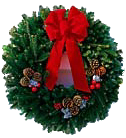
Christmas Store
The holidays are just around the corner so now is the time to fetch the finest gifts for the Labrador Lover on your Christmas list. We have over 100 gifts $50.00 and under. Visit our Christmas Store.
For the Lab
Bedding
Coats
Collars and Leads
Dog Bowls
Feeding Stations
Spa and Grooming
Toys and Treats
Travel and Accessories
For the Lab Lover
Apparel
Cards and Giftwrap
Fine Accessories
Gifts and All Occasions
Jewelry
Kids Only
For the Lab Home
Artwork
Books
Garden and Outdoor
Home Furnishings
Kitchen Accessories
Pillows, Throws, and Rugs
Gift ServicesGift Boxes
Gift Certificates
Swiss Chocolate, Skiing and Labs: A Perfect Recipe for Fun
By Josh Hagy
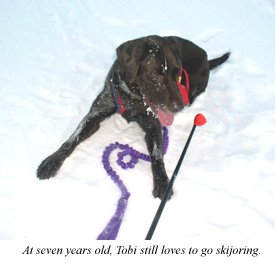 Every ski resort in the world has bunny trails, but in Alaska and some other snowy states will you find doggie trails with a unique ski-type activity perfect for man’s best friend, something Gail Davidson and her chocolate Lab, Toblerone know all too well.
Every ski resort in the world has bunny trails, but in Alaska and some other snowy states will you find doggie trails with a unique ski-type activity perfect for man’s best friend, something Gail Davidson and her chocolate Lab, Toblerone know all too well.
Gail and Toblerone (Tobi for short) are avid fans of skijoring, a wintertime activity that has become a pastime for many in Alaska. “Tobi would rather skijor than do anything else in the world,” said Gail. She doesn't retrieve, except maybe to annoy her best buddy Maggie, a Chesapeake, and she doesn't swim except to cool off.”
 Skijoring, at first glance, looks like a cross between skiing and a dogsled race. “Basically, you put a special harness around yourself, usually around the waist and sometimes under the legs, kind of like a climbing harness. You hitch to that a long cord, most preferably with a bungee in it, and then put a harness on the dog,” explained Gail. Once the rig is complete, it’s off to the races.
Skijoring, at first glance, looks like a cross between skiing and a dogsled race. “Basically, you put a special harness around yourself, usually around the waist and sometimes under the legs, kind of like a climbing harness. You hitch to that a long cord, most preferably with a bungee in it, and then put a harness on the dog,” explained Gail. Once the rig is complete, it’s off to the races.
Any dog that has an aptitude for skijoring can take up the sport. While some skijorers seem to prefer Alaskan Huskies for skijoring, Pointers crossed with Alaskan Huskies have also recently become popular. For Gail, however, there is no better dog than Tobi her chocolate Lab. “She can beat lots of dogs. Of course, it doesn’t only depend on the dog, but on the skier as well. The young guys who are really fast skiers do well. And if they have young and fast dogs ,, it’s a winning combination.”
Skijoring races are held throughout Alaska, including those sponsored by the Alaska Skijoring and Pulk Association (ASPA). “We have a skijoring club that puts on races. Anyone can go out there as long as their dog gets along with other dogs,” said Gail. The distance each race covers can vary from one mile to eight or ten miles. “Generally there are one minute interval starts andif all the dogs start at once, they get kind of excited,” she added.
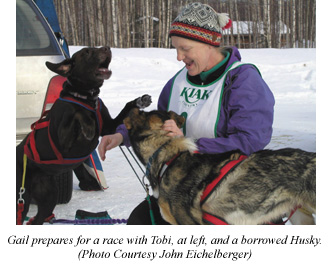 Tobi has earned herself quite a reputation on the racing circuit, but for a surprising reason. Tobi loves skijoring so much that she hates to see a race end. So much so that, instead of finishing, she often stops before she ever crosses the finish line. “It’s quite annoying,” Gail said, laughing at the thought. “This is an odd thing about Tobi that is well known around here. She does not like to finish a race and that’s because she doesn’t like to stop. So, sort of perversely, she stops before the finish line, like 20 feet before. At one place the finish on a hill and she and I have to drag her uphill across the line.”
Tobi has earned herself quite a reputation on the racing circuit, but for a surprising reason. Tobi loves skijoring so much that she hates to see a race end. So much so that, instead of finishing, she often stops before she ever crosses the finish line. “It’s quite annoying,” Gail said, laughing at the thought. “This is an odd thing about Tobi that is well known around here. She does not like to finish a race and that’s because she doesn’t like to stop. So, sort of perversely, she stops before the finish line, like 20 feet before. At one place the finish on a hill and she and I have to drag her uphill across the line.”
Tobi has been hitting the skijoring trails since she was nine months old. “We do runs for fun on all kinds of trails, races with the Alaska Skijoring and Pulk Association (ASPA), and trips to remote cabins around Fairbanks and the rest of Alaska. Tobi pulls me and my pulk (sled) to cabins, mostly on groomed trails,” said Gail.
That may seem like a lot of running, but Tobi is more than up for it. “She just loves to run. In the summer, she’ll go out and run with a person. This dog is so focused on running with people that she mostly stays on the trail and she doesn’t run around sniffing things like most dogs do.” Not only is Tobi an avid runner, but she’s a quick study as well.
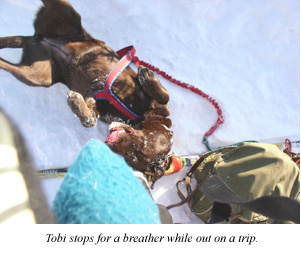 As with any canine sport, there are special commands the owner must relay to her dog. In skijoring, just like dog sledding, there are two very important ones, “gee” and “haw”. “It didn’t seem to take much training for her to learn the commands. ‘Gee’ is right and ‘haw’ is left. She learned very quickly to gee and haw, and it was in summer that I taught her to do that. She seems to know just from the feel of me behind her which way we’re going to go. A lot of times, we’ll have run a trail before and when we cover the trail again, she remember where she’s going. If she doesn’t , she will look back at me and wait for me to tell her.”
As with any canine sport, there are special commands the owner must relay to her dog. In skijoring, just like dog sledding, there are two very important ones, “gee” and “haw”. “It didn’t seem to take much training for her to learn the commands. ‘Gee’ is right and ‘haw’ is left. She learned very quickly to gee and haw, and it was in summer that I taught her to do that. She seems to know just from the feel of me behind her which way we’re going to go. A lot of times, we’ll have run a trail before and when we cover the trail again, she remember where she’s going. If she doesn’t , she will look back at me and wait for me to tell her.”
Gail can’t explain Tobi’s love for skijoring, but then again, she can’t explain her own love for it either. “When I first moved to Alaska 28 years ago, and it was the first time I saw it, I had a black Lab then and I thought, ‘Hmm, my dog can do that.’ Then I got a yellow Lab and she did it too. When I first hooked Tobi up she was about nine months old and she just took off. I have no idea what makes one dog love the sport and the other not, but she absolutely loves it.”
While her interest in skijoring began roughly 28 years ago, her love of Labs goes back just about as far. She had two Labs prior to Tobi, a black Lab and a yellow Lab, but she couldn’t help but want a chocolate Lab. Fortunately for her, she found what she wanted in Tobi. “I heard from a school teacher that her mother’s dog was having puppies. We heard that they were born and they weren’t very old, so at first we thought we’d better go to the pound and look. We went, and there was actually a chocolate Lab there. She was an alpha female and I didn’t want to bring an alpha female into the house with Maggie, so I went back to the puppies.”
She took her newfound chocolate Lab home with her, where a Swiss exchange student who was staying with her at the time helped christen her. “Chocolate Labs just seem to have chocolate names, like Mocha or something similar,” said Gail. “So we came up with something slightly different. Toblerone is actually a Swiss chocolate. It’s really hard to say unless you’re Swiss, so we call her Tobi for short.”
Seven years later, Tobi and Gail are still hitting the skijoring trails. Unfortunately, their efforts this season have been hampered by a lack of snow and an injury. “Tobi tore her ACL two years ago. It has been a really great recovery, even the vet was impressed. However, at Christmas this year she tore her other one. So we’re down for the season,” Gail shared.
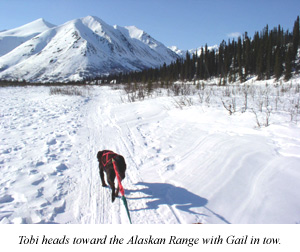 Tobi’s injury will heal in time and when it does, there is no doubt that these two will be back on the skijoring trails. After all, Tobi loves to run and Gail has found her own enjoyment in skijoring. “I have a special rapport with my dog and running with someone else’s dogs is sort of like just having an engine.” And for Gail, running with her dog is a great pleasure because she really enjoys watching her four-legged partner have fun. Tobi is now seven, so she’s not as fast as she once was. Gail doesn’t seem to mind though, “She doesn’t necessarily win all the time, but that’s not the point. We have fun together. It’s a great time.”
Tobi’s injury will heal in time and when it does, there is no doubt that these two will be back on the skijoring trails. After all, Tobi loves to run and Gail has found her own enjoyment in skijoring. “I have a special rapport with my dog and running with someone else’s dogs is sort of like just having an engine.” And for Gail, running with her dog is a great pleasure because she really enjoys watching her four-legged partner have fun. Tobi is now seven, so she’s not as fast as she once was. Gail doesn’t seem to mind though, “She doesn’t necessarily win all the time, but that’s not the point. We have fun together. It’s a great time.”
As soon as Tobi has recovered from her injury, she and Gail will hit the trails once again, where they will enjoy skijoring, even if Tobi doesn’t know when to cross the finish line. For Gail, her Lab is always a winner.
Give Skijoring a Try
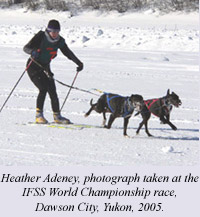 Skijoring began in Scandinavia in the late 1800’s when folks harnessed themselves to horses or reindeer for transportation. Dogs eventually proved more practical and initially a small weighted sled called a pulk was placed between the skier and the dogs.
Skijoring began in Scandinavia in the late 1800’s when folks harnessed themselves to horses or reindeer for transportation. Dogs eventually proved more practical and initially a small weighted sled called a pulk was placed between the skier and the dogs.
Although skijoring has been very popular in Scandinavia, in North America it wasn’t until the mid-1980’s that the sport became more than a dog training technique when the Alaska Dog Musher’s Association added skijoring classes to some dog-sled races. Now there is a world championship which draws competitors from all over the globe. Dog enthusiasts recognize it as an activity they can participate in with one or more dogs and with minimal equipment.
Skijoring (Norwegian for “ski-driving” combining the words “ski” with “jor” the Norwegian word for “ride” or “drive”) is not much more than hooking up a towline to your four legged friend and having him pull you merrily along through the snow on your skis.
Skijoring is not just for owners of Huskies either. An excellent skier won the North American one-dog race not long ago with his house pet-a black Labrador Retriever.
You don’t have to compete to enjoy skijoring with your dog—with minimal skijor equipment, an eager dog and a pair of cross country skis, the trails are all yours!
Any dog over the age of one year, and in general good health, can pull a skijorer. The classic northern breeds, such as Siberian and Alaskan Huskies, Malamutes, Inuit dogs, take to skijoring with glee. However, any pet dog is capable of enjoying this. Border Collies, Golden Retrievers, Giant Schnauzers, Labs, and many cross-breeds are seen in harnesses.
What you need
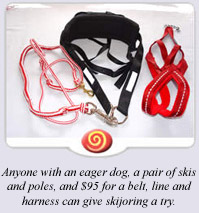 Beginning Basics
Beginning Basics
Getting your dog to respond like Rin-Tin-Tin takes a bit of practice. The dogs are taught the classic mushing commands to start running (hike), turn (‘gee’-right and ‘haw’-left), and stop (whoa). Training is best done on foot, before the person straps on skis to avoid being pulled into objects like trees or half frozen creeks.
Start slow. Keep it fun and just have a good time!
Set aside the notion that the skier is being towed. The skier, like a good jockey, does everything possible to unburden the dog, allowing it to either reach its maximum speed or maintain a slower pace for distance.
All dogs pull instinctively; but certain breeds possess the drive, conformation and strength to excel in sprint races while others displaying those same positive traits, plus thicker coats, wider paws and a tougher psychology are better adapted for distance races or touring. An average of 55 pounds is a good rule of thumb, but bigger in this case truly is better.
Stopping competently on skis is a must. Not being able to stop endangers the dog and yourself.
Finally, be sure to brush up on trail protocol. There are classes, books and videos to help, and remember to pack pooper-scooper bags.
Then go out and have some fun! For winter couch potatoes-on four feet or two-it’s a great way to burn off calories.
The best part of all is the constant connection and companionship with you and your dog(s).
Click here to go back to Lab of the Month
By Josh Hagy
 Every ski resort in the world has bunny trails, but in Alaska and some other snowy states will you find doggie trails with a unique ski-type activity perfect for man’s best friend, something Gail Davidson and her chocolate Lab, Toblerone know all too well.
Every ski resort in the world has bunny trails, but in Alaska and some other snowy states will you find doggie trails with a unique ski-type activity perfect for man’s best friend, something Gail Davidson and her chocolate Lab, Toblerone know all too well.Gail and Toblerone (Tobi for short) are avid fans of skijoring, a wintertime activity that has become a pastime for many in Alaska. “Tobi would rather skijor than do anything else in the world,” said Gail. She doesn't retrieve, except maybe to annoy her best buddy Maggie, a Chesapeake, and she doesn't swim except to cool off.”
 Skijoring, at first glance, looks like a cross between skiing and a dogsled race. “Basically, you put a special harness around yourself, usually around the waist and sometimes under the legs, kind of like a climbing harness. You hitch to that a long cord, most preferably with a bungee in it, and then put a harness on the dog,” explained Gail. Once the rig is complete, it’s off to the races.
Skijoring, at first glance, looks like a cross between skiing and a dogsled race. “Basically, you put a special harness around yourself, usually around the waist and sometimes under the legs, kind of like a climbing harness. You hitch to that a long cord, most preferably with a bungee in it, and then put a harness on the dog,” explained Gail. Once the rig is complete, it’s off to the races.Any dog that has an aptitude for skijoring can take up the sport. While some skijorers seem to prefer Alaskan Huskies for skijoring, Pointers crossed with Alaskan Huskies have also recently become popular. For Gail, however, there is no better dog than Tobi her chocolate Lab. “She can beat lots of dogs. Of course, it doesn’t only depend on the dog, but on the skier as well. The young guys who are really fast skiers do well. And if they have young and fast dogs ,, it’s a winning combination.”
Skijoring races are held throughout Alaska, including those sponsored by the Alaska Skijoring and Pulk Association (ASPA). “We have a skijoring club that puts on races. Anyone can go out there as long as their dog gets along with other dogs,” said Gail. The distance each race covers can vary from one mile to eight or ten miles. “Generally there are one minute interval starts andif all the dogs start at once, they get kind of excited,” she added.
 Tobi has earned herself quite a reputation on the racing circuit, but for a surprising reason. Tobi loves skijoring so much that she hates to see a race end. So much so that, instead of finishing, she often stops before she ever crosses the finish line. “It’s quite annoying,” Gail said, laughing at the thought. “This is an odd thing about Tobi that is well known around here. She does not like to finish a race and that’s because she doesn’t like to stop. So, sort of perversely, she stops before the finish line, like 20 feet before. At one place the finish on a hill and she and I have to drag her uphill across the line.”
Tobi has earned herself quite a reputation on the racing circuit, but for a surprising reason. Tobi loves skijoring so much that she hates to see a race end. So much so that, instead of finishing, she often stops before she ever crosses the finish line. “It’s quite annoying,” Gail said, laughing at the thought. “This is an odd thing about Tobi that is well known around here. She does not like to finish a race and that’s because she doesn’t like to stop. So, sort of perversely, she stops before the finish line, like 20 feet before. At one place the finish on a hill and she and I have to drag her uphill across the line.”Tobi has been hitting the skijoring trails since she was nine months old. “We do runs for fun on all kinds of trails, races with the Alaska Skijoring and Pulk Association (ASPA), and trips to remote cabins around Fairbanks and the rest of Alaska. Tobi pulls me and my pulk (sled) to cabins, mostly on groomed trails,” said Gail.
That may seem like a lot of running, but Tobi is more than up for it. “She just loves to run. In the summer, she’ll go out and run with a person. This dog is so focused on running with people that she mostly stays on the trail and she doesn’t run around sniffing things like most dogs do.” Not only is Tobi an avid runner, but she’s a quick study as well.
 As with any canine sport, there are special commands the owner must relay to her dog. In skijoring, just like dog sledding, there are two very important ones, “gee” and “haw”. “It didn’t seem to take much training for her to learn the commands. ‘Gee’ is right and ‘haw’ is left. She learned very quickly to gee and haw, and it was in summer that I taught her to do that. She seems to know just from the feel of me behind her which way we’re going to go. A lot of times, we’ll have run a trail before and when we cover the trail again, she remember where she’s going. If she doesn’t , she will look back at me and wait for me to tell her.”
As with any canine sport, there are special commands the owner must relay to her dog. In skijoring, just like dog sledding, there are two very important ones, “gee” and “haw”. “It didn’t seem to take much training for her to learn the commands. ‘Gee’ is right and ‘haw’ is left. She learned very quickly to gee and haw, and it was in summer that I taught her to do that. She seems to know just from the feel of me behind her which way we’re going to go. A lot of times, we’ll have run a trail before and when we cover the trail again, she remember where she’s going. If she doesn’t , she will look back at me and wait for me to tell her.”Gail can’t explain Tobi’s love for skijoring, but then again, she can’t explain her own love for it either. “When I first moved to Alaska 28 years ago, and it was the first time I saw it, I had a black Lab then and I thought, ‘Hmm, my dog can do that.’ Then I got a yellow Lab and she did it too. When I first hooked Tobi up she was about nine months old and she just took off. I have no idea what makes one dog love the sport and the other not, but she absolutely loves it.”
While her interest in skijoring began roughly 28 years ago, her love of Labs goes back just about as far. She had two Labs prior to Tobi, a black Lab and a yellow Lab, but she couldn’t help but want a chocolate Lab. Fortunately for her, she found what she wanted in Tobi. “I heard from a school teacher that her mother’s dog was having puppies. We heard that they were born and they weren’t very old, so at first we thought we’d better go to the pound and look. We went, and there was actually a chocolate Lab there. She was an alpha female and I didn’t want to bring an alpha female into the house with Maggie, so I went back to the puppies.”
She took her newfound chocolate Lab home with her, where a Swiss exchange student who was staying with her at the time helped christen her. “Chocolate Labs just seem to have chocolate names, like Mocha or something similar,” said Gail. “So we came up with something slightly different. Toblerone is actually a Swiss chocolate. It’s really hard to say unless you’re Swiss, so we call her Tobi for short.”
Seven years later, Tobi and Gail are still hitting the skijoring trails. Unfortunately, their efforts this season have been hampered by a lack of snow and an injury. “Tobi tore her ACL two years ago. It has been a really great recovery, even the vet was impressed. However, at Christmas this year she tore her other one. So we’re down for the season,” Gail shared.
 Tobi’s injury will heal in time and when it does, there is no doubt that these two will be back on the skijoring trails. After all, Tobi loves to run and Gail has found her own enjoyment in skijoring. “I have a special rapport with my dog and running with someone else’s dogs is sort of like just having an engine.” And for Gail, running with her dog is a great pleasure because she really enjoys watching her four-legged partner have fun. Tobi is now seven, so she’s not as fast as she once was. Gail doesn’t seem to mind though, “She doesn’t necessarily win all the time, but that’s not the point. We have fun together. It’s a great time.”
Tobi’s injury will heal in time and when it does, there is no doubt that these two will be back on the skijoring trails. After all, Tobi loves to run and Gail has found her own enjoyment in skijoring. “I have a special rapport with my dog and running with someone else’s dogs is sort of like just having an engine.” And for Gail, running with her dog is a great pleasure because she really enjoys watching her four-legged partner have fun. Tobi is now seven, so she’s not as fast as she once was. Gail doesn’t seem to mind though, “She doesn’t necessarily win all the time, but that’s not the point. We have fun together. It’s a great time.”As soon as Tobi has recovered from her injury, she and Gail will hit the trails once again, where they will enjoy skijoring, even if Tobi doesn’t know when to cross the finish line. For Gail, her Lab is always a winner.
Give Skijoring a Try
 Skijoring began in Scandinavia in the late 1800’s when folks harnessed themselves to horses or reindeer for transportation. Dogs eventually proved more practical and initially a small weighted sled called a pulk was placed between the skier and the dogs.
Skijoring began in Scandinavia in the late 1800’s when folks harnessed themselves to horses or reindeer for transportation. Dogs eventually proved more practical and initially a small weighted sled called a pulk was placed between the skier and the dogs.Although skijoring has been very popular in Scandinavia, in North America it wasn’t until the mid-1980’s that the sport became more than a dog training technique when the Alaska Dog Musher’s Association added skijoring classes to some dog-sled races. Now there is a world championship which draws competitors from all over the globe. Dog enthusiasts recognize it as an activity they can participate in with one or more dogs and with minimal equipment.
Skijoring (Norwegian for “ski-driving” combining the words “ski” with “jor” the Norwegian word for “ride” or “drive”) is not much more than hooking up a towline to your four legged friend and having him pull you merrily along through the snow on your skis.
Skijoring is not just for owners of Huskies either. An excellent skier won the North American one-dog race not long ago with his house pet-a black Labrador Retriever.
You don’t have to compete to enjoy skijoring with your dog—with minimal skijor equipment, an eager dog and a pair of cross country skis, the trails are all yours!
Any dog over the age of one year, and in general good health, can pull a skijorer. The classic northern breeds, such as Siberian and Alaskan Huskies, Malamutes, Inuit dogs, take to skijoring with glee. However, any pet dog is capable of enjoying this. Border Collies, Golden Retrievers, Giant Schnauzers, Labs, and many cross-breeds are seen in harnesses.
What you need
 Beginning Basics
Beginning BasicsGetting your dog to respond like Rin-Tin-Tin takes a bit of practice. The dogs are taught the classic mushing commands to start running (hike), turn (‘gee’-right and ‘haw’-left), and stop (whoa). Training is best done on foot, before the person straps on skis to avoid being pulled into objects like trees or half frozen creeks.
Start slow. Keep it fun and just have a good time!
Set aside the notion that the skier is being towed. The skier, like a good jockey, does everything possible to unburden the dog, allowing it to either reach its maximum speed or maintain a slower pace for distance.
All dogs pull instinctively; but certain breeds possess the drive, conformation and strength to excel in sprint races while others displaying those same positive traits, plus thicker coats, wider paws and a tougher psychology are better adapted for distance races or touring. An average of 55 pounds is a good rule of thumb, but bigger in this case truly is better.
Stopping competently on skis is a must. Not being able to stop endangers the dog and yourself.
Finally, be sure to brush up on trail protocol. There are classes, books and videos to help, and remember to pack pooper-scooper bags.
Then go out and have some fun! For winter couch potatoes-on four feet or two-it’s a great way to burn off calories.
The best part of all is the constant connection and companionship with you and your dog(s).
Click here to go back to Lab of the Month
Featured Article
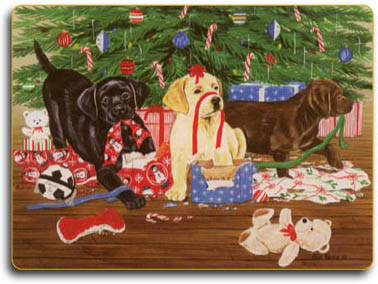 Can You Spot The Holiday Hazards?
Can You Spot The Holiday Hazards?
It’s easy for pets, especially Labradors, to get into trouble during the holidays. You may get so busy that you lose track of what is going on with your dog.
Click here to learn more about: "Can You Spot The Holiday Hazards?"
 Can You Spot The Holiday Hazards?
Can You Spot The Holiday Hazards?It’s easy for pets, especially Labradors, to get into trouble during the holidays. You may get so busy that you lose track of what is going on with your dog.
Click here to learn more about: "Can You Spot The Holiday Hazards?"
Wanted: Models

Would you like to see your Lab pictured here? Send us images of your Lab and we may include them on our Home Page!

Would you like to see your Lab pictured here? Send us images of your Lab and we may include them on our Home Page!
Labrador Library
Labrador Links
The Verstaile Lab
History of the Lab
Advice
Travel
Featured Labs
Featured Artists
Labrador Links
The Verstaile Lab
History of the Lab
Advice
Travel
Featured Labs
Featured Artists
.jpg)

